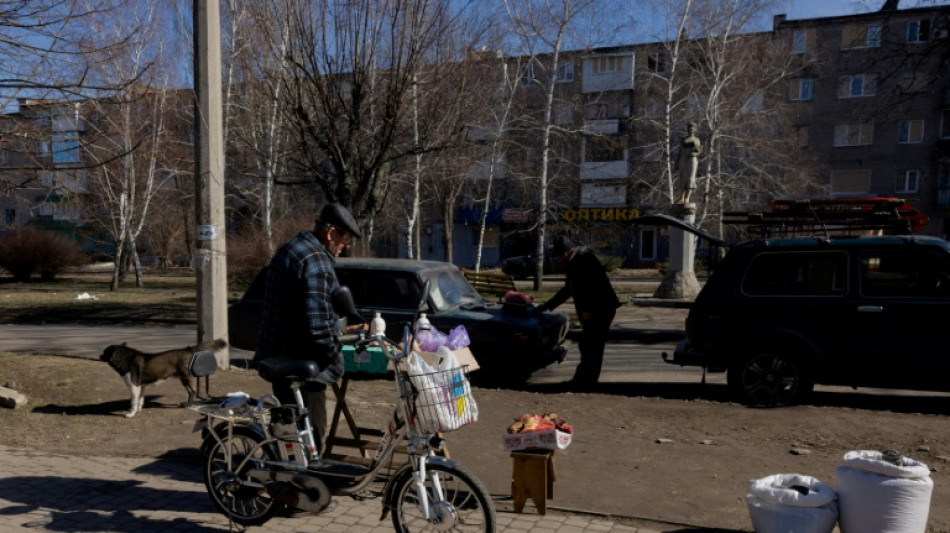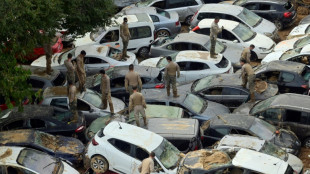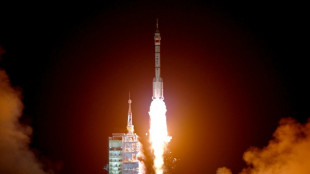
-
 World leaders set to attend Francis's funeral as cardinals gather
World leaders set to attend Francis's funeral as cardinals gather
-
Gold hits record, stocks mixed as Trump fuels Fed fears

-
 Roche says will invest $50 bn in US over next five years
Roche says will invest $50 bn in US over next five years
-
Fleeing Pakistan, Afghans rebuild from nothing

-
 US Supreme Court to hear case against LGBTQ books in schools
US Supreme Court to hear case against LGBTQ books in schools
-
Pistons snap NBA playoff skid, vintage Leonard leads Clippers

-
 Migrants mourn pope who fought for their rights
Migrants mourn pope who fought for their rights
-
Duplantis kicks off Diamond League amid Johnson-led changing landscape

-
 Taliban change tune towards Afghan heritage sites
Taliban change tune towards Afghan heritage sites
-
Kosovo's 'hidden Catholics' baptised as Pope Francis mourned

-
 Global warming is a security threat and armies must adapt: experts
Global warming is a security threat and armies must adapt: experts
-
Can Europe's richest family turn Paris into a city of football rivals?

-
 Climate campaigners praise a cool pope
Climate campaigners praise a cool pope
-
As world mourns, cardinals prepare pope's funeral

-
 US to impose new duties on solar imports from Southeast Asia
US to impose new duties on solar imports from Southeast Asia
-
Draft NZ law seeks 'biological' definition of man, woman

-
 Auto Shanghai to showcase electric competition at sector's new frontier
Auto Shanghai to showcase electric competition at sector's new frontier
-
Tentative tree planting 'decades overdue' in sweltering Athens

-
 Indonesia food plan risks 'world's largest' deforestation
Indonesia food plan risks 'world's largest' deforestation
-
Gold hits record, stocks slip as Trump fuels Fed fears

-
 Trump helps enflame anti-LGBTQ feeling from Hungary to Romania
Trump helps enflame anti-LGBTQ feeling from Hungary to Romania
-
Woe is the pinata, a casualty of Trump trade war

-
 'Like orphans': Argentina mourns loss of papal son
'Like orphans': Argentina mourns loss of papal son
-
Trump tariffs torch chances of meeting with China's Xi

-
 X rival Bluesky adds blue checks for trusted accounts
X rival Bluesky adds blue checks for trusted accounts
-
China to launch new crewed mission into space this week

-
 Morocco volunteers on Sahara clean-up mission
Morocco volunteers on Sahara clean-up mission
-
Latin America fondly farewells its first pontiff

-
 'I wanted it to work': Ukrainians disappointed by Easter truce
'I wanted it to work': Ukrainians disappointed by Easter truce
-
Harvard sues Trump over US federal funding cuts

-
 'One isn't born a saint': School nuns remember Pope Francis as a boy
'One isn't born a saint': School nuns remember Pope Francis as a boy
-
Battling Forest see off Spurs to boost Champions League hopes

-
 'I don't miss tennis' says Nadal
'I don't miss tennis' says Nadal
-
Biles 'not so sure' about competing at Los Angeles Olympics

-
 Gang-ravaged Haiti nearing 'point of no return', UN warns
Gang-ravaged Haiti nearing 'point of no return', UN warns
-
US assets slump again as Trump sharpens attack on Fed chief

-
 Forest see off Spurs to boost Champions League hopes
Forest see off Spurs to boost Champions League hopes
-
Trump says Pope Francis 'loved the world,' will attend funeral

-
 Oscar voters required to view all films before casting ballots
Oscar voters required to view all films before casting ballots
-
Bucks' Lillard upgraded to 'questionable' for game 2 v Pacers

-
 Duplantis and Biles win Laureus World Sports Awards
Duplantis and Biles win Laureus World Sports Awards
-
US urges curb of Google's search dominance as AI looms

-
 The Pope with 'two left feet' who loved the 'beautiful game'
The Pope with 'two left feet' who loved the 'beautiful game'
-
With Pope Francis death, Trump loses top moral critic

-
 Mourning Americans contrast Trump approach to late Pope Francis
Mourning Americans contrast Trump approach to late Pope Francis
-
Leeds and Burnley promoted to Premier League

-
 Racist gunman jailed for life over US supermarket massacre
Racist gunman jailed for life over US supermarket massacre
-
Trump backs Pentagon chief despite new Signal chat scandal

-
 Macron vows to step up reconstruction in cyclone-hit Mayotte
Macron vows to step up reconstruction in cyclone-hit Mayotte
-
Gill, Sudharsan help toppers Gujarat boss Kolkata in IPL


Russian drones and glide bombs stretch Ukraine front
Living in the gutted-out eastern Ukrainian city of Kostyantynivka, Maryna has learned to recognise the sound of the devastating Russian glide bombs that have pounded her city for months.
Equipped with wings to help them glide over dozens of kilometres, the bombs are part of an arsenal developed by Russia to let it hit deeper into Ukrainian territory and stretch the front line.
Maryna recalled to AFP just one of the recent strikes.
"Six people didn't get back up. There was blood everywhere," she said.
Overhead, the threat of a fresh attack is constant.
In a recent visit to the city, AFP reporters saw Russian planes flying over frequently and a dozen strikes in the area in less than half an hour.
Each drop triggered a blast, seeming to unfold in slow motion, followed by a high column of black smoke.
Kostyantynivka used to be relatively sheltered, lying a dozen kilometres (7 miles) from the front line.
But Russian forces are now pounding the city with the cheaply made bombs.
Usually made from Soviet stocks and modernised with satellite control systems, each can carry up to a tonne of explosives.
The glide bombs themselves are mostly impossible to intercept for the Ukrainian airforce, whose only option is to try to shoot down the planes.
Throughout the three-year war, Russia has used them to devastating effect -- razing cities like Chasiv Yar to the ground and obliterating Ukrainian defensive positions across the front line.
- Attacks increased tenfold -
Selling produce from his farm on a folding table on the side of a damaged road, Maryna's husband Volodymyr said the explosions had crippled his business.
"My cow is producing less milk because of the blasts, and my pigs are having miscarriages one after the other," he said.
He also has fewer clients, as most civilians have fled.
Attacks increased tenfold in February, according to governor Vadym Filashkin, who is urging residents to evacuate.
Children and their guardians were ordered to leave the city in autumn 2024.
The eastern districts of the town, closer to the front, also face relentless drone attacks.
"I can hear them buzzing as soon as I leave the house," said Volodymyr, who barely escaped alive when his home was hit in a drone attack.
He recently counted 108 drones in one week.
"When you hear them, you raise your arms and wait," he said, explaining how he signalled to Russian drone operators that he was a civilian.
Ukraine, too, has used drones extensively throughout the conflict -- for frontline hits and reconnaissance for long-range strikes deep inside Russian territory.
A few kilometres from the front line, Ronin and Archie, two young Ukrainian soldiers, were training on first-person view (FPV) drones, which are piloted remotely by operators donning virtual reality-like goggles.
The relatively cheap drones are ever-present at the front, leading both sides to develop various electronic warfare tools to neutralise them.
To overcome jamming, both have developed fibre optic drones equipped with thin cables tethered to the operator, rendering them immune to radio or signal interference.
"The enemy has many more than we do. And they often use them successfully," 21-year-old Ronin said.
"We are more exposed and we spend more time holding our positions," Archie, 24, said.
- 'More exposed' -
The fibre optic drones can reach up to 20 kilometres.
Soldiers often resort to shotguns, whose multiple pellets are useful to shoot down the nimble drones.
The threat also complicates the provision of medical aid to wounded soldiers.
Cameras on drones can spot the ambulances -- now forced to work at night -- sent to collect wounded soldiers.
In a stabilisation point -- an emergency shelter to treat soldiers close to the front -- an anaesthetist who goes by "Frenchie" said the drones had expanded the danger zone.
"In 2022, being two kilometres from the line, it felt like we were on vacation," said the 31-year-old doctor, before running to attend to a soldier whose leg had been torn by a drone blast.
"I want to believe and believe in God, because we have no one else," Volodymyr said.
"Even if they have to negotiate for years, let them stop bombing people," Maryna said.
S.Leonhard--VB
